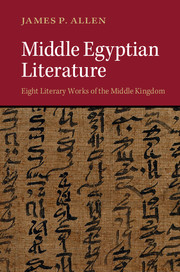Book contents
- Frontmatter
- Contents
- Introduction
- Text 1 The Story of the Shipwrecked Sailor
- Text 2 The Story of Sinuhe
- Text 3 The Loyalist Instruction
- Text 4 The Instructions of Kagemni's Father and Ptahhotep
- Text 5 The Discourses of the Eloquent Peasant
- Text 6 The Debate between a Man and His Soul
- Text 7 The Herdsman's Tale
- Text 8 Hymns to Senwosret III
- Consecutive Translations
Text 5 - The Discourses of the Eloquent Peasant
Published online by Cambridge University Press: 05 January 2015
- Frontmatter
- Contents
- Introduction
- Text 1 The Story of the Shipwrecked Sailor
- Text 2 The Story of Sinuhe
- Text 3 The Loyalist Instruction
- Text 4 The Instructions of Kagemni's Father and Ptahhotep
- Text 5 The Discourses of the Eloquent Peasant
- Text 6 The Debate between a Man and His Soul
- Text 7 The Herdsman's Tale
- Text 8 Hymns to Senwosret III
- Consecutive Translations
Summary
As a work of literature, this composition is second in importance only to the Story of Sinuhe. It is attested in several Middle Kingdom copies, all in hieratic on papyri:
B1 — pAmherst 1 and pBerlin 3023
The beginning of the composition is lost (to R 2, 3) and the text breaks off before the end (B2 91–142). This papyrus was written by the same scribe who wrote the B manuscript of Sinuhe. Parkinson 1991; Parkinson 2012a, CD folder “Pap. Berlin P. 3023 The Tale of the Eloquent Peasant B1.”
B2 —pAmherst 2 and pBerlin 3025
The papyrus as preserved contains the end of the composition (from B1 263) and is the only copy to preserve the final lines (after B1 357). It is written exclusively in vertical columns on the recto. Parkinson 1991; Parkinson 2012a, CD folder “Pap. Berlin P. 3025 The Tale of the Eloquent Peasant B2.”
Bt — pButler (BM 10274)
This copy preserves the beginning of the composition except for the opening lines (R 2, 1–8, 6). It is written in vertical columns except for the list of goods (Bt 1–14). Griffith 1892; Parkinson 1991.
R — pRamesseum A (Berlin 10499), recto
This copy preserves the beginning of the text; the end is lost. Written horizontally except for three columns. Vogelsang and Gardiner 1908; Parkinson 1991.
B1 can be dated to the coregency of Senwosret III and Amenemhat III (p. 56, above), B2 and Bt are contemporary or slightly later (Parkinson 1991, xxvi), and R dates to the first part of Dyn. XIII or slightly earlier (p. 56, above).
The original was composed in the first half of Dyn. XII. An unusual blend of two genres, stories and wisdom texts, it begins and ends as a story but its bulk is devoted to nine lengthy discourses on the nature of Maat, which are the reason for its existence. The text is also the most consciously “literary” of Middle Egyptian compositions, replete with metaphors and carefully crafted sentences.
- Type
- Chapter
- Information
- Middle Egyptian LiteratureEight Literary Works of the Middle Kingdom, pp. 229 - 326Publisher: Cambridge University PressPrint publication year: 2014



